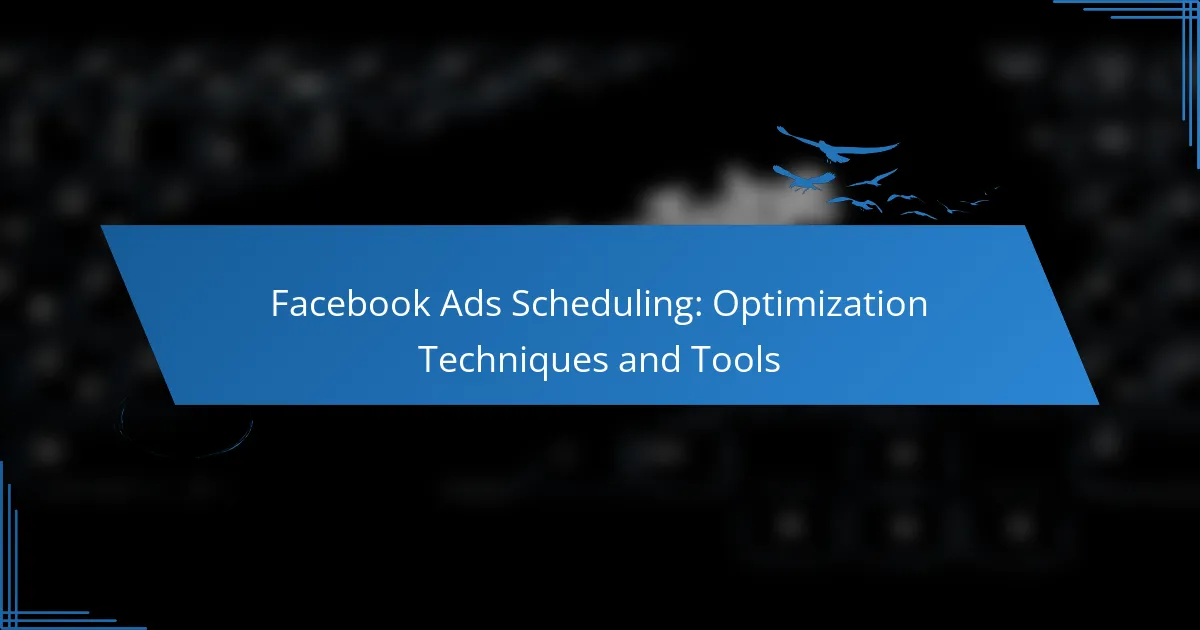Optimizing Facebook Ads scheduling is crucial for maximizing visibility and engagement with your target audience. By analyzing user behavior patterns and leveraging specialized tools, advertisers can strategically plan their campaigns to align with when users are most active. This approach not only enhances ad performance but also improves overall return on investment.
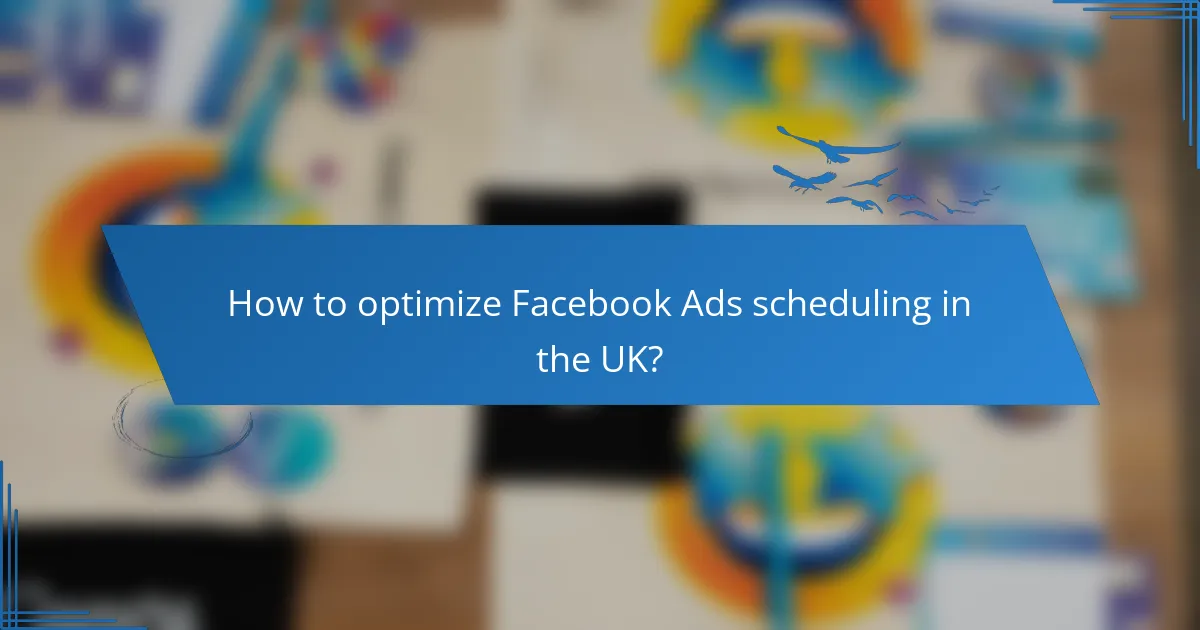
How to optimize Facebook Ads scheduling in the UK?
To optimize Facebook Ads scheduling in the UK, focus on identifying when your target audience is most active and engaged. This involves analyzing user behavior patterns and adjusting your ad delivery accordingly to maximize visibility and interaction.
Utilize peak engagement times
Identifying peak engagement times is crucial for effective Facebook Ads scheduling. Typically, users are most active during early mornings, lunch breaks, and evenings. Consider scheduling your ads to run during these high-traffic periods to increase the likelihood of user interaction.
Use Facebook Insights to analyze when your audience is online. This tool provides data on user activity, helping you pinpoint the best times to display your ads. Adjusting your ad schedule to align with these peak times can significantly enhance performance.
Leverage A/B testing for timing
A/B testing is an effective method to determine the optimal timing for your Facebook Ads. By running two versions of an ad at different times, you can compare engagement rates and identify which time slot yields better results.
Start by selecting a few time slots that align with your peak engagement periods. Monitor the performance over a week or two, and analyze metrics such as click-through rates and conversions. This data-driven approach allows you to refine your scheduling strategy based on real user behavior.
Adjust for time zone differences
When targeting audiences across different regions in the UK, it’s essential to adjust your ad scheduling for time zone differences. The UK operates on Greenwich Mean Time (GMT) and British Summer Time (BST), which can affect when your ads are seen.
Ensure that your ads are scheduled to run during local peak times for each specific region. Utilize Facebook’s ad scheduling tools to set specific times based on the time zones of your target audience. This adjustment can help you avoid wasted impressions and improve overall ad effectiveness.
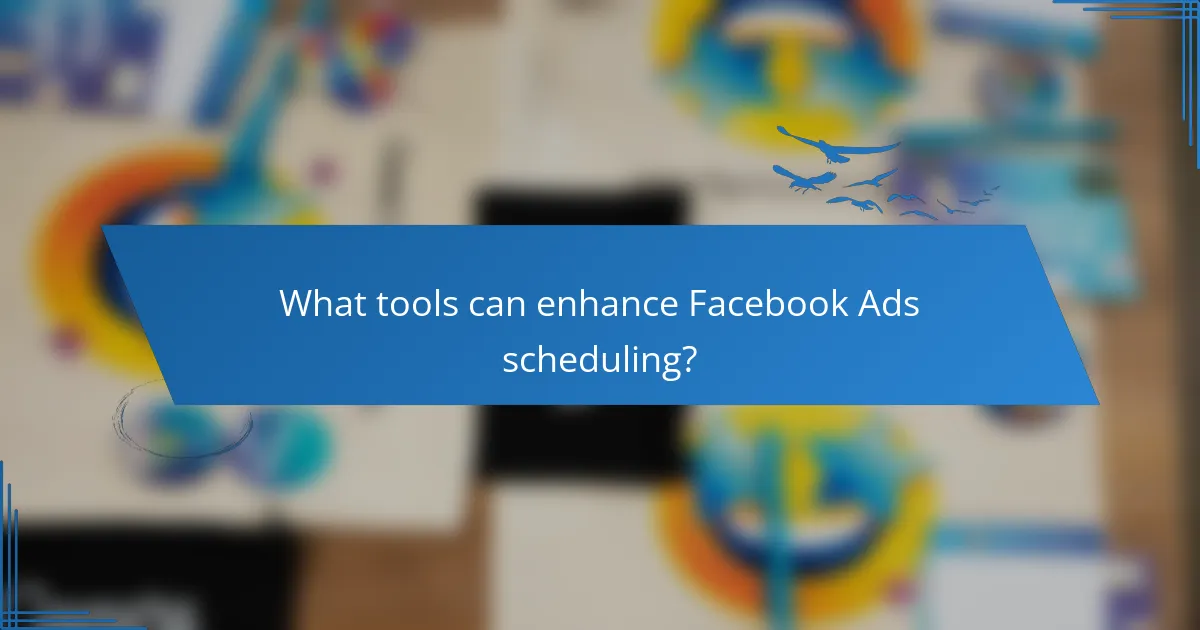
What tools can enhance Facebook Ads scheduling?
Several tools can significantly improve the scheduling of Facebook Ads, allowing advertisers to optimize their campaigns for better performance. Utilizing these tools can help manage ad timing, analyze audience behavior, and streamline the overall ad management process.
Facebook Ads Manager
Facebook Ads Manager is the primary platform for creating, managing, and analyzing Facebook ad campaigns. It offers robust scheduling features that allow advertisers to set specific start and end dates for their ads, as well as to choose optimal times for ad delivery based on audience engagement patterns.
When using Ads Manager, consider leveraging the “Ad Scheduling” option, which enables you to run ads only during specific hours or days of the week. This can help maximize your budget by targeting users when they are most likely to engage with your content.
Hootsuite Ads
Hootsuite Ads is a comprehensive tool that integrates with Facebook to streamline ad management and scheduling. It allows users to create and schedule ads across multiple platforms from a single dashboard, making it easier to maintain a cohesive advertising strategy.
With Hootsuite Ads, you can analyze performance metrics and adjust your scheduling based on real-time data. This flexibility ensures that your ads are running at peak times, which can lead to improved click-through rates and conversions.
AdEspresso by Hootsuite
AdEspresso is designed for marketers looking to optimize their Facebook ad campaigns through detailed analytics and A/B testing. This tool simplifies the ad creation process and offers advanced scheduling options to ensure your ads reach the right audience at the right time.
One of the key features of AdEspresso is its ability to automate ad scheduling based on performance data. By using this tool, you can set rules that automatically adjust your ad delivery based on engagement metrics, helping you to allocate your budget more effectively.
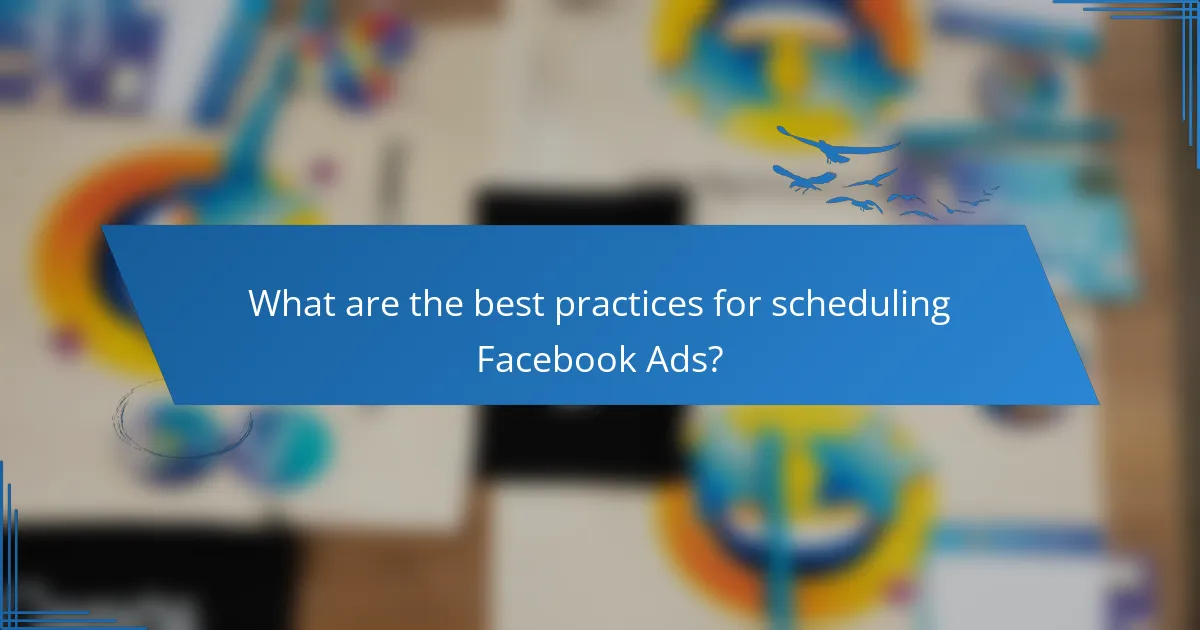
What are the best practices for scheduling Facebook Ads?
Effective scheduling of Facebook Ads involves strategic planning to maximize reach and engagement. By aligning your ad campaigns with audience behavior and campaign goals, you can enhance performance and return on investment.
Define clear campaign objectives
Establishing clear campaign objectives is crucial for effective ad scheduling. Determine whether your goal is brand awareness, lead generation, or sales conversion, as this will influence when and how often you run your ads.
For instance, if your objective is to boost sales during a holiday season, consider scheduling ads to run in the weeks leading up to the holiday when potential customers are actively shopping.
Monitor audience insights
Regularly monitoring audience insights helps you understand when your target demographic is most active on Facebook. Use Facebook’s Audience Insights tool to analyze user behavior, demographics, and peak activity times.
Adjust your ad scheduling based on these insights. For example, if you find that your audience is most engaged on weekends, prioritize your ad spend during those days to maximize visibility and interaction.
Set a consistent posting schedule
Creating a consistent posting schedule is essential for maintaining audience engagement. Aim to post ads at regular intervals, which can help establish familiarity and anticipation among your audience.
Consider using a content calendar to plan your ad placements. This approach allows you to balance promotional content with engaging posts, ensuring your audience remains interested without feeling overwhelmed by ads.
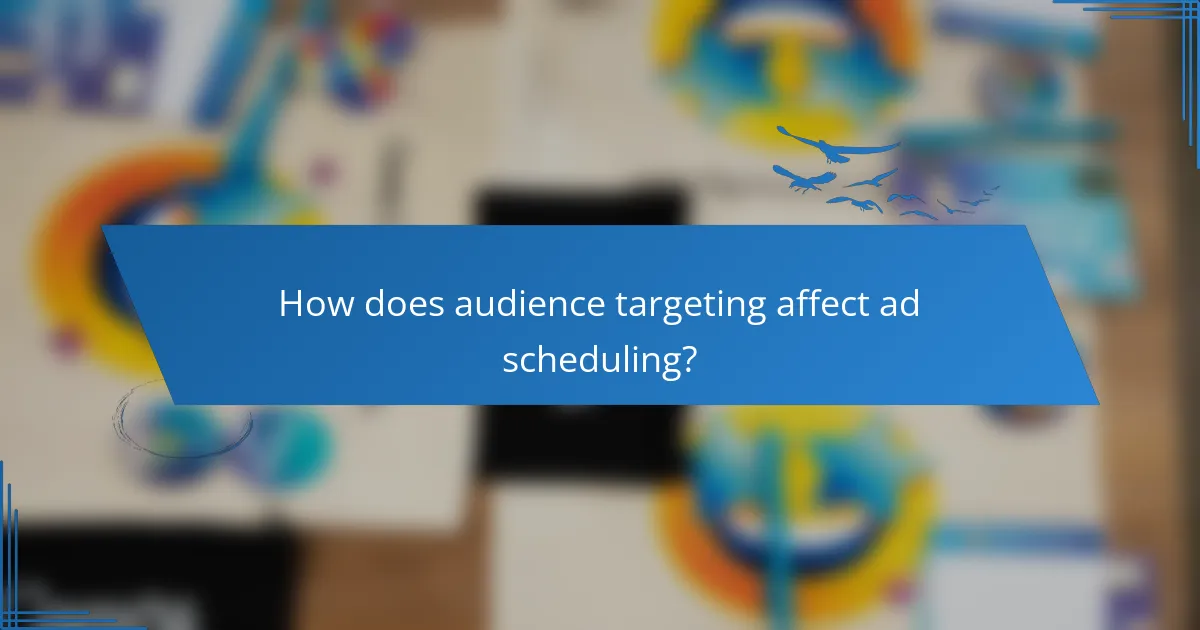
How does audience targeting affect ad scheduling?
Audience targeting significantly influences ad scheduling by determining when and how often ads reach specific user segments. By aligning ad delivery with the times when target audiences are most active, advertisers can enhance engagement and conversion rates.
Segment audiences by demographics
Demographic segmentation involves categorizing audiences based on characteristics such as age, gender, location, and income. Understanding these factors allows advertisers to schedule ads during peak times for each demographic group. For instance, ads aimed at younger audiences may perform better in the evenings or weekends, while older demographics might engage more during weekdays.
To optimize ad scheduling, consider creating separate campaigns for different demographic segments. This approach enables tailored messaging and timing, enhancing the likelihood of reaching users when they are most receptive.
Analyze user behavior patterns
User behavior analysis reveals when specific audiences are most active online. By examining metrics such as peak engagement times and historical performance data, advertisers can identify optimal ad scheduling windows. For example, if data shows that users engage more with ads during lunch hours, scheduling ads around that time can yield better results.
Utilize Facebook’s analytics tools to track user interactions and refine your ad scheduling strategy. Regularly reviewing this data helps in adapting to changing behavior patterns, ensuring that ads are consistently reaching audiences at the right moments.
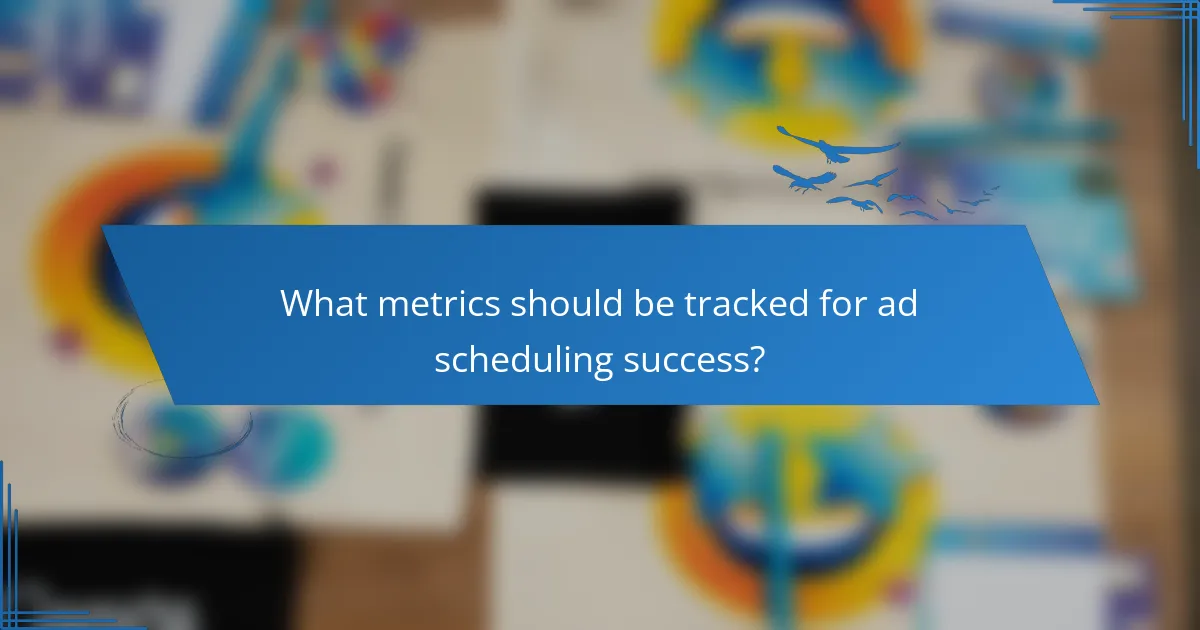
What metrics should be tracked for ad scheduling success?
To measure ad scheduling success on Facebook, focus on key metrics such as click-through rates (CTR), conversion rates, and engagement metrics. These indicators provide insights into how effectively your ads are performing and help optimize your scheduling strategy.
Click-through rates (CTR)
Click-through rate (CTR) is a crucial metric that indicates the percentage of users who click on your ad after seeing it. A higher CTR suggests that your ad is relevant and appealing to your target audience. Aim for a CTR in the range of 1-3% for most industries, but this can vary based on your niche.
To improve CTR, consider testing different ad formats, headlines, and visuals. Regularly analyze which times of day yield the highest CTR and adjust your scheduling accordingly. Avoid running ads during periods of low engagement, which can dilute your overall performance.
Conversion rates
Conversion rates measure the percentage of users who complete a desired action after clicking on your ad, such as making a purchase or signing up for a newsletter. A good conversion rate typically falls between 2-5%, but this can differ based on your industry and target audience.
To enhance conversion rates, ensure that your landing pages are optimized for user experience and aligned with your ad messaging. Track conversions closely during different times of the day to identify peak performance periods, allowing you to schedule ads when they are most likely to convert.
Engagement metrics
Engagement metrics encompass various interactions users have with your ads, including likes, shares, and comments. High engagement rates indicate that your content resonates with your audience, which can lead to increased visibility and reach. Aim for engagement rates of around 1-5% as a benchmark.
To boost engagement, create compelling content that encourages interaction, such as questions or calls to action. Monitor engagement trends over time to identify the best times for posting, and adjust your ad scheduling to maximize interactions during those peak periods.
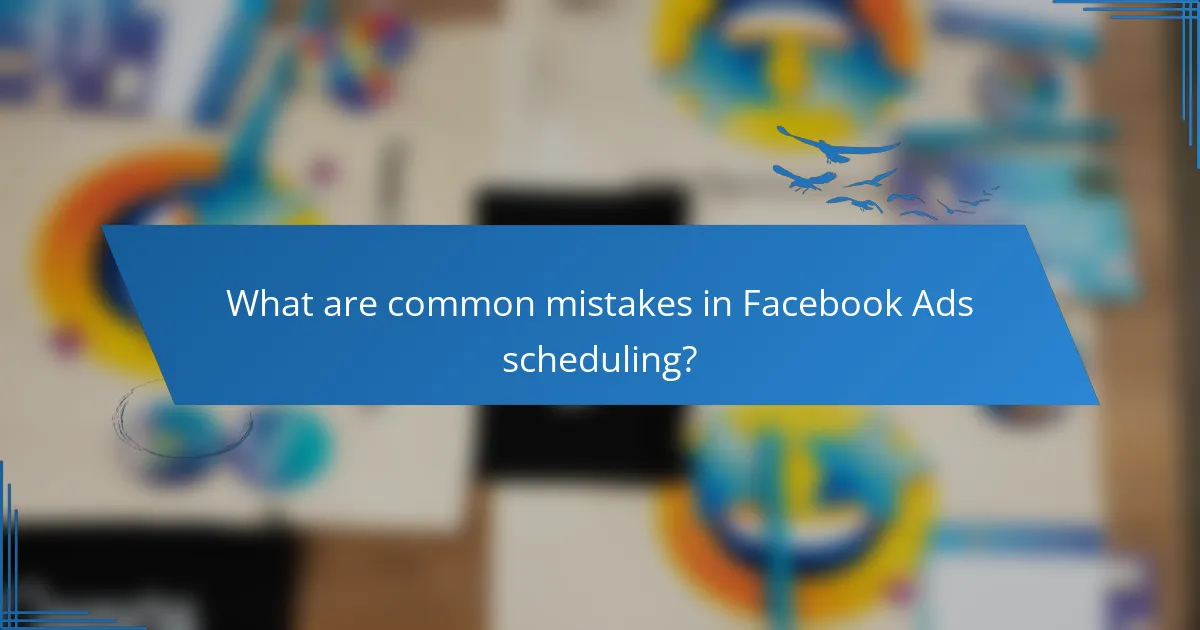
What are common mistakes in Facebook Ads scheduling?
Common mistakes in Facebook Ads scheduling can significantly impact campaign performance. Key errors include ignoring time zone differences and failing to test various schedules to find the most effective timing for your audience.
Ignoring time zone differences
Many advertisers overlook the importance of time zone differences when scheduling Facebook Ads. This can lead to ads being shown at times when the target audience is less active, reducing engagement and conversion rates.
To optimize ad performance, consider the time zones of your target audience. If you are targeting users across multiple regions, adjust your scheduling to align with peak activity times in each zone. For instance, if you’re targeting both Eastern and Pacific time zones in the U.S., schedule ads to run during the late morning to early evening hours in both regions.
Not testing different schedules
Failing to test different ad schedules is another common mistake that can hinder campaign success. Without testing, you may miss out on identifying the optimal times for reaching your audience effectively.
Implement A/B testing to compare various scheduling options. For example, run ads during weekdays versus weekends or test different times of day. Analyze the performance metrics, such as click-through rates and conversions, to determine which schedule yields the best results. Regularly revisiting and adjusting your ad schedule based on performance data is crucial for ongoing optimization.
